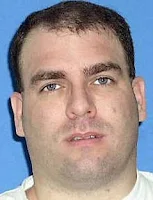 |
| Larry Swearingen |
Walking through the woods that Saturday, Raglind made a grisly discovery. In a clearing not far from where a deer had recently been cleaned, there was a human body. "At first, I thought it was a mannequin."
It was indeed a body, that of 19-year-old Melissa Trotter, a Montgomery College student who had been missing since Dec. 8, 1998. That day, during finals week, she had been seen around the college by a number of people: She attended a science class review session, went to the cafeteria, and did some studying and other work on a school computer in the college library. Then she was gone. In fact, the section of woods where she was ultimately found had been searched by police several times before Raglind came along.
Although they had not yet found her body, police investigating her disappearance were fairly certain that Trotter was dead, and they believed they knew who was responsible: Larry Swearingen, a 27-year-old local electrician, married with two young children and a history of getting himself in trouble with the law. Swearingen had been seen talking with Trotter at the college the day she disappeared. The state maintains he was the last to see her alive.
Three days after Trotter disappeared, police arrested Swearingen on outstanding warrants. He's been behind bars ever since. After Trotter's body was found, he was charged with capital murder. The state charged that Swearingen kidnapped her from the college, raped her, and tied a single panty hose leg around her neck, strangling her before dumping her body in the national forest. There was no direct evidence – no DNA, for example – linking Swearingen to the crime, and there was no certain evidence that Trotter had been the victim of sexual assault.
But there was a good deal of circumstantial evidence linking Swearingen to the disappearance and death. He had been seen with her at the school the day she disappeared, several hairs matching Trotter were found in Swearingen's pickup truck (although he did not dispute that they were friends), and, most damning, during their third search of Swearingen's home, police said they were given a leg of panty hose that Swearingen's landlord had found while cleaning up Swearingen's rented trailer. A Department of Public Safety analyst later said it was a positive match to the leg found tied around Trotter's neck.
Time of Death
Swearingen maintains his innocence, but he was tried and convicted in the summer of 2000; after less than two hours of jury deliberation, he was sentenced to death. Since 2007, he's been scheduled for execution three times but has avoided lethal injection thanks to court-imposed stays – including one late last month granted by the state's highest criminal court, the Austin-based Court of Criminal Appeals, which sent the case back to district court for further review. At issue is the forensic science of death and decomposition. More than a decade after Trotter's death, a growing number of scientists – including pathologists, forensic anthropologists, and entomologists – agree that Swearingen could not have been responsible for Trotter's death.
Specifically at issue is histological evidence (analysis of cell tissue) that nearly a half-dozen doctors have reviewed and that they say shows conclusively that Trotter had not been dead for 25 days at the time she was found in January 1999. Samples of cardiac, lung, and vascular tissues harvested from Trotter at autopsy, saved in a paraffin block and finally recovered from the Harris County Medical Examiner's Office by Swearingen's attorney in 2009, show tissue that is hardly decomposed at all and is most consistent with a person who has been dead less than a week.
If Trotter was dead less than a week when her body was discovered, Swearingen was in jail when she died and could not have killed her.
Source: The Chronicle, August 19, 2011
Related articles:
Jul 29, 2011
Swearingen was convicted of the 1998 kidnap-rape-murder of 19-year-old Melissa Trotter in Montgomery County. Prosecutors have said – and the CCA has previously agreed – that a "mountain" of evidence links Swearingen to...
Aug 07, 2011
Evidence on her body and a pile of circumstantial evidence implicated Mr. Swearingen. A jury convicted him of kidnapping, raping and killing the teenager and sentenced him to death in 2000. Since his conviction, though, ...
Jan 27, 2009
Larry Swearingen, 37, faced lethal injection Tuesday evening for the death of Melissa Trotter, whose body was found Jan. 2, 1999, in the Sam Houston National Forest south of Huntsville. The discovery came 25 days after ...
Jan 26, 2009
Larry Swearingen, 37, faced lethal injection Tuesday evening for the death of Melissa Trotter, whose body was found Jan. 2, 1999, in the Sam Houston National Forest south of Huntsville. The discovery came 25 days after ...
Comments
Post a Comment
Pro-DP comments will not be published.